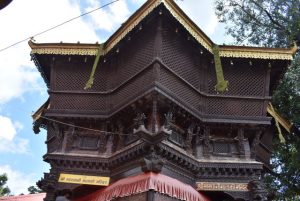Nestled in the tranquil town of Sankhu, just north of Kathmandu, Nepal, the Swasthani Mata Temple stands as a beacon of devotion and ancient wisdom. This revered temple, dedicated to the goddess Swasthani, draws countless pilgrims seeking blessings, healing, and spiritual enlightenment. The temple’s rich history, intricate architecture, and vibrant festivals weave a tapestry of cultural and religious significance, making it a compelling destination for those seeking a deeper understanding of Nepali culture.
Stock Photos and Videos of Nepal
Shutterstock Alamy Pond5 Dreamstime 500px
Historical Significance of Swasthani Mata Temple

Ancient Origins
The temple’s exact origins are shrouded in the mists of time, but it is believed to have been established centuries ago, perhaps as early as the 14th century. The temple’s dedication to Swasthani, an embodiment of the feminine divine, reflects a long-standing tradition of goddess worship in Nepal.
Growth and Expansion
Over the centuries, the temple has undergone several phases of construction and renovation. The existing structure, a beautiful example of traditional Nepali architecture, is likely a result of these gradual expansions, reflecting the enduring devotion of the local community.
Modern Importance
In recent decades, the Swasthani Mata Temple has become an even more significant pilgrimage site, attracting visitors from far and wide. The temple’s popularity is a testament to the power of faith and the enduring appeal of ancient traditions.
Architectural Features of the Temple
Traditional Nepali Style
The temple showcases the classic features of Nepali pagoda architecture, with its tiered roof adorned with ornate carvings and vibrant colors. The roof’s upward curve symbolizes the ascent toward spiritual enlightenment.
Sacred Details
Every element of the temple holds symbolic significance. The intricately carved wooden doors depict scenes from Hindu mythology, while the colorful murals narrate tales of devotion and spiritual awakening.
Serene Courtyard
Surrounding the main temple structure is a peaceful courtyard, often shaded by ancient trees. This tranquil space provides a sanctuary for meditation and contemplation, fostering a connection with the divine.
Festivals and Celebrations at Swasthani Mata Temple
Swasthani Brata Katha
The most important festival celebrated at the temple is the Swasthani Brata Katha, a month-long observance dedicated to the goddess Swasthani. Devotees perform rituals, listen to sacred narratives, and offer prayers for health, prosperity, and a happy marriage.
Diwali
The festival of lights, Diwali, is also celebrated enthusiastically at the temple. The temple is illuminated with thousands of diyas (oil lamps), creating a mesmerizing spectacle of light and devotion.
Other Festivals
Throughout the year, the temple hosts several other festivals and celebrations, attracting pilgrims and locals alike. These events provide opportunities for spiritual growth, community bonding, and cultural immersion.
Myths and Legends Associated with the Temple
The Origin Story
According to legend, the goddess Swasthani appeared to a devoted sage, granting him boons and blessings. In gratitude, the sage built the temple in her honor, establishing it as a sacred site for seeking grace.
The Tale of Sati
The temple is also associated with the story of Sati, a devoted wife who sacrificed herself to protect her husband’s honor. The temple’s devotees believe that Swasthani embodies Sati’s unwavering love and devotion.
The Power of Faith
These myths and legends serve as powerful reminders of the importance of faith, devotion, and spiritual practices. They inspire countless pilgrims to seek the goddess’s blessings and guidance in their lives.
Importance of the Temple in the Local Community
Spiritual Center
The temple serves as a spiritual center for the people of Sankhu and surrounding areas. It provides a place for worship, prayer, and meditation, fostering a sense of community and shared faith.
Social Hub
The temple also serves as a social hub, where people gather for festivals, community events, and religious gatherings. This fosters a sense of belonging and strengthens bonds within the community.
Cultural Preservation
The temple plays a vital role in preserving Nepali culture and traditions. Through its festivals, rituals, and architecture, it passes on the rich heritage of Nepal to future generations.
Visiting the Temple: Tips and Guidelines
Dress Code Wear modest clothing, covering shoulders and knees.
Footwear Remove shoes before entering the temple.
Behavior Maintain silence and respect while inside the temple.
Offerings Offer flowers, incense, or fruits as a gesture of devotion.
Photography Ask permission before taking photos inside the temple.
Conclusion and Key Takeaways
Spiritual Serenity
The Swasthani Mata Temple offers a sanctuary for peace, tranquility, and spiritual connection. It is a place where devotees can seek solace, guidance, and a deeper understanding of the divine.
Cultural Heritage
The temple is a testament to the rich cultural heritage of Nepal. Its architecture, festivals, and legends reflect a deep connection to ancient traditions and beliefs.
Community Center
The temple plays a vital role in the local community, serving as a spiritual center, a social hub, and a place for cultural preservation.
Devotion and Faith
The temple inspires devotion and faith in the goddess Swasthani, reminding us of the power of belief, love, and self-sacrifice.
DISCLAIMER: This was generated with the help of AI. This technology is new and constantly improving. Please verify the accuracy before sharing.

